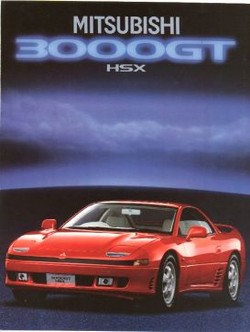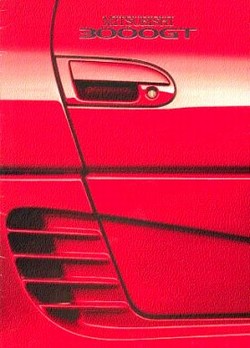PH Zeroes: Mitsubishi 3000GT
So much technology it threatened to take over the world, Terminator-style. Tony Middlehurst revisits the Mitsubishi 3000GT...
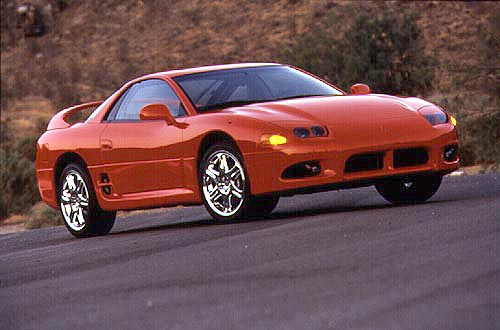
I don’t like cockles, whelks or any other rubbery seafood. That’s for sure. Or is it? Why am I suddenly confused about this vital fish-based question? It’s all down to the Mitsubishi 3000GT. I thought I’d long since reached the point where all my opinions were set in stone, but revisiting this car has changed all that.
Join me for a few moments in the early 1990s. It was the time of Noel’s House Party, the first Pentium chip, and the big Japanese coupé. With its huge 300ZX, Nissan was notably failing to recapture the magic of the 240Z. Toyota’s not-much-nicer entry into the class was the flabby Supra.
And if you were a gambling man with an aptitude for home engineering and, ideally, your own metallurgy laboratory, you could choose Mazda’s brave but flawed RX-7.
Mitsubishi’s 1990 contribution to this burgeoning bruiser coupé market was the 3000GT. In essence, the 3000GT – or GTO if you lived in Japan (they took the ‘O’ off export models so that Ferrari or Pontiac enthusiasts wouldn’t think they were taking the Mick) – was a fuel-injected, 24-valve, 3-litre V6-powered 2+2.
But it was much more than that. It was an event. Looking at it now, it’s hard to believe, but when it was new this Mitsu made a big splash. Not so much the first ones, which came with a normally-aspirated 220bhp twin-cam, or a weedy single-cam 160bhp lump if you were unlucky enough to be American. Even the 5-speed 220 wasn’t man enough to back up the performance promise of something that looked like every schoolboy’s dream but weighed the same as half an elephant.
The obvious answer was more power. Enter the twin-turbo, twin-intercooler VR-4. VR-4 stood for Viscous Realtime 4, an all-wheel-drive system with a fluid coupling between the front and rear wheels. If one end started to break away, torque would be transferred to the other end until the loose wheels could ‘catch up’.
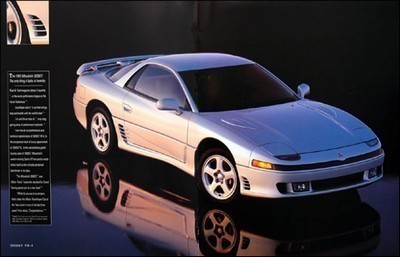
With just over 400Nm of torque (more than any Evo) going through a tough new Getrag 6-speed box, the system was worth having. With between 280bhp and 320bhp, depending on who you believed, and the AWD system keeping it all pretty much between the kerbs, the VR-4 was good for 155mph and a 0-60 time of under six seconds.
Properly quick, then. But performance wasn’t the 3000GT’s main party piece. That was technology. Bucketloads of the stuff. And that was its downfall.
Mitsubishi threw the whole toy box at it in hopes of luring buyers away not just from the blue-collar opposition mentioned above but also away from Honda’s relatively godlike NSX. So the 3kgt had all-wheel drive, all-wheel steering, all-wheel ABS, electronically-controlled suspension, a tuneable exhaust, pop-up headlights, enough instrumentation to make a jumbo jet pilot’s head spin, an Electronic Time and Alarm Control System, whatever that was, and something called ‘Active Aerodynamics’ – automatically-adjusting spoilers at both ends, deploying at 80kph and retracting at 50kph.
This kind of complication might not seem so unusual nowadays, with even the squiggiest ’09 supermini packing in enough computing power to spank Spassky at chess, but back in the ‘90s the dazzling electro-trickery of the 3000GT really was something special.
It was also quite mad. Apart from its 1.7-ton bulk and girth, the 3000GT was absolutely loaded with stuff that looked more than capable of breaking down. Mitsubishi seemed to realise this itself fairly early on, quietly carrying out a de-contenting programme through much of the early ‘90s in order to ‘disappear’ some of the dafter stuff. By the mid-‘90s the ECS and Active Aero package had gone, as had the pop-up headlamps, a concept which in all of motoring history has never really worked for anybody.
What’s a 3000GT like as an ownership proposition? Risky. The Germans have always justified their engineering arrogance by pointing proudly to the longevity of their products. In contrast, the Japanese have only recently started to shift from a position of combining German-style engineering arrogance with built-in obsolescence. No Japanese cars of this, or as far as I can see any, era were ever built with home maintenance in mind.

This is uniquely annoying to anyone who might be interested in a long-term relationship with a complex Japanese vehicle like the 3000GT. When faults occur on any oldish car, as they invariably do, they’re a pain. On a 3000GT they’re awkward, expensive, ruinous, or all three. Suspension struts and steering racks disintegrate, pulleys whirl and whizz off, gaiters perish, belts snap. New clutch, sir? Certainly, that will be One Thousand Pounds.
To some extent this is all to be expected on a performance car. But the biggest bills lurk in the 3000GT’s sparky bits. On this car, ‘ECU’ (of which it has more than a few) stands for Extremely Costly, Unfortunately. A new engine ECU will set you back One Thousand Pounds. Lose the gearbox ECU and, depending on how unlucky you are, the resultant transmission damage might well cost you Two And A Half Thousand Pounds to mend. Either ECU failure could precipitate a total write-off.
Even if you manage to buy a new ECU at a reasonable price, your next problem could be fitting it. The one for the ABS, for example, is located in the front inner wing. To get at it, all you have to do is strip out the wheel, suspension, arch lining and front wing. Hmm.
Those active spoilers weren’t expected to fail – well, not within the warranty period, anyway – but of course they will eventually do exactly that. Fortunately, mending the microswitched, plastic-geared motors is a simple matter of a few hours’ work with a small selection of surgeon’s instruments, some emery paper, an electron microscope and an industrial laser.
What we’re saying is, be careful. 3000GT fault diagnosis is almost as exact a science as panda-sexing. As one member of the UK GTO owners club wittily puts it on his blogging signature, his pride and joy was ‘designed for speed, built for storage’. Don’t expect much help from your Mitsubishi dealer either, unless they’ve got an Old Bert type in the workshop who remembers them. Often as not, a Mitsubishi man in a suit will simply outsource you and your inconvenient problem, expensively.
Buying a 3000GT in 2009 could be a bit like buying an Amstrad home computer, also in 2009. Or you might get lucky and enjoy several years of happy use. The good ones that are left will most likely be genuinely good, but finding an unmolested one won’t be easy. Used 3000GTs have always held a certain fascination among those who really wanted their genitals enhanced but who didn’t fancy the operation. Instead they would spend all their money on giving the 3000GT the performance they felt it should have had in the first place.
‘Performance shops’, often located in the more desolate parts of England, would happily separate GT owners from their cash in exchange for five-inch exhausts, convincing-looking dyno sheets, glitter-effect ‘500bhp’ stickers and various go-faster products from companies that sound like rap artists. Purveyors of fluorescent lighting would also assist 3000GT owners in their quest to illuminate the road surface in lurid colours as they go along.

If you’re serious, and know the right people, you can monster a 3000GT up to a genuine 800bhp and a nine-second quarter-mile potential, but beware: just 400bhp will put a stock GT bottom end in jeopardy. Even un-tuned turbo engines have a habit of blowing off hoses at inopportune moments. Blowing off is never nice, especially in mixed company, but it’s especially unwelcome on a GT because there are just so many hoses under that bonnet. Finding a blown-off one can be a long job.
Would you buy one? As a result of excess tuning and laddish driving, a fair percentage of the 3000GTs now on sale in the UK are labelled ‘damaged repairable’. As a general rule, if you’re buying a tuned GT it’s probably best to avoid anything with unexplained soiling on the driver’s seat. A good unmessed GT will be £5-£6k, and a very good late-model low-miler around £7k. Just try and make sure that all its ECUs are marching in tune with the band.
Legend has it that Mitsubishi made a convertible version for one year only, from ’95 to ’96. That must have had some really serious problems to have suffered such an early demise, but if nothing else it must have some rarity value. You’ll be lucky to find one of them, but fear not: at the other end of the availability scale there are lots of cheap Japanese-import GTOs around, which at least indicates a pleasing degree of survivability.
Owners of genuine UK models who paid the full whack for their motors detest these imports for infecting the entire breed with catastrophic depreciation. You can see how that would be slightly annoying when the UK list price was over £35k in 1992 and getting on for £45k by the end of production in 2001. So £5k for a nice used one doesn’t seem quite so bad.
Clearly, buying a 3000GT can be an edgy lifestyle choice. You may end up wearing a jacket with the buttons up the back instead of the front. But of course this dangerous madness is all part of the 3000GT’s appeal. If you wanted to make it a ‘Zero turned Hero’, I wouldn’t argue with you.
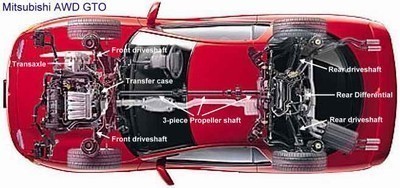
The 3000GT was ahead of its time, and not always in a good way, but there’s no doubt that the once-lardy styling looks miles better now than it did in the ‘90s. The performance is definitely there, and comfort is beyond question thanks to the lavishly appointed 2+2 leather cockpit and decent ride.
But still – would you take the plunge? Well, it depends on whether you consider the 3000GT a Zero or a Hero. This car features in Crap Cars… but then it also won Motor Trend magazine’s car of the year award in its class.
On balance, I reckon Zero. But just let me try those whelks again…
Gassing Station | General Gassing | Top of Page | What's New | My Stuff


